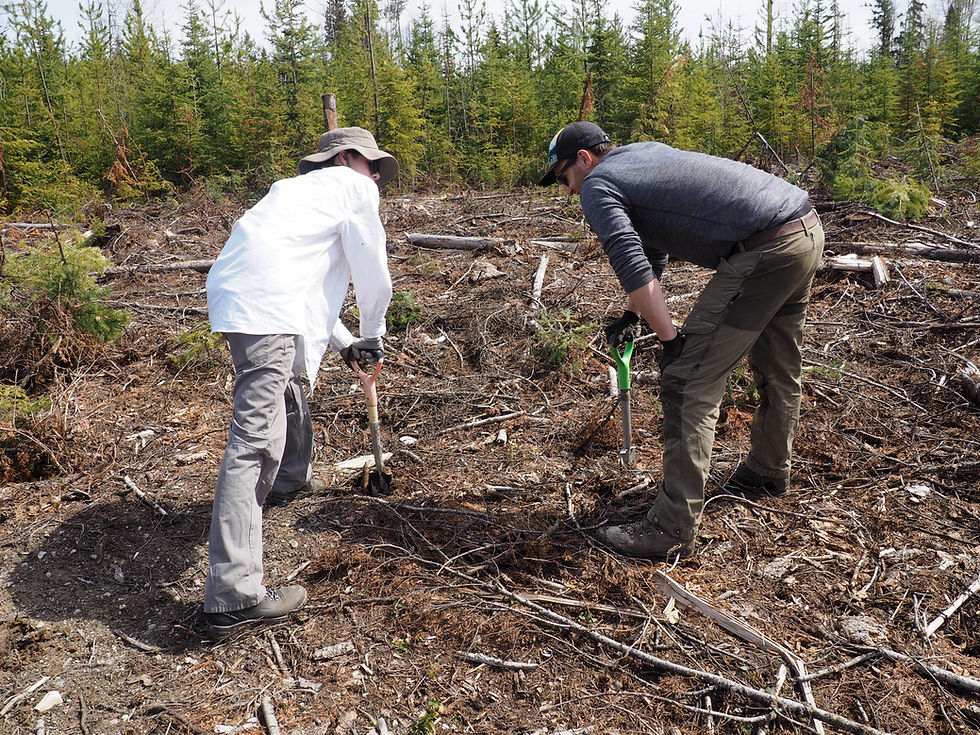- Jordan Tesluk
- Jun 22
- 3 min read
Updated: Aug 7
Answer: Focus on one or two key things each day to develop muscle memory and incrementally improve your planting motions.
Becoming a good tree planter means refining one's movement to achieve the peak of efficiency and speed. However, what is best for production is not always best for the body.
Top Ten Imperatives
The amount of training that workers receive on ergonomics can range from a few short instructions to several hours with physiotherapists or kinesiologists who specialize in planting. Total Physio is considered the leading expert in ergonomics for tree planters, and they worked with the Western Forestry Contractors Association to produce an instructional video that outlines the Top 10 Biomechanical Imperatives for Tree Planters. This guide is shared widely in most planting workplaces, but only a few companies use these instructional tips to their full potential. An effective strategy for turning the guidelines into motions requires breaking things down into digestible pieces.
For Tree Planters
While each individual imperative or movement is fairly simple to understand, it is difficult for even the most experienced planter to remember and practice all ten at the same time. Just like any complex sport, planting can and should be broken down into fundamental smaller movements and practiced so that good habits develop.
Thus, a good strategy is to focus on one or two movements each day. For example, you can focus on tucking in your chin one day, "walking like a cowboy or cowgirl" the next day, and hitting "the neutral zone" the next day. This approach can help you develop good habits and muscle memory, so that positive ergonomics become part of your natural movement. Once your movements are properly patterned, your mind can be free to focus on other things.
Veteran planters should not assume they have nothing to gain from re-evaluating their techniques. Even highly experienced planters have achieved significant improvements in comfort and freedom in movement by integrating the top 10 imperatives into their routines.
For Crew Bosses
If you are a crew boss, and you want to ensure your crew members are developing good habits, consider demonstrating one or two of the biomechanical imperatives each day during your tailgate meeting. Then observe the workers and review their progress when you conduct your quality checks through the day. As a supervisor, a crew boss is responsible for ensuring the safety of the workers under their care, and taking reasonable steps to prevent musculoskeletal injuries should be considered an important part of the crew boss position.
Crew bosses should also lead by example. Every tailgate meeting should start off with a round of "jelly pumps" to keep workers focused on positive ergonomics each day.
There is more to planting than rushing from tree to tree
Shaving a few minutes off your day with movement shortcuts provides little benefit if it results in your production dropping off later due to a sore back. Moreover, having poor ergonomics means you may not be using your body efficiently, and fatiguing faster than you need to.
The biomechanical imperatives help use your muscles properly, and help avoid overloading critical body parts. For example, "walking like a cowboy (or cowgirl)" and slightly turning your knees to the outside helps bring your gluteus maximus (buttocks) into your movement pattern and alleviates strain on other parts of the back and leg. With your buttocks being the most powerful muscle in your body, you are missing out on a big part of your engine if you do not engage these muscles properly when you move.
Some of the fastest planters look like they are only casually strolling through the land. Smooth and efficient movement beats shortcuts and rushed movements any day of the week.
Think about the long term
It is not uncommon for tree planters to have mild to moderate ongoing muscular problems many years after they finish planting. This could include a femur that rotates inwards, causing pain in the knee when walking down stairs, or knots in the middle back as a result of shoulders and ribs not moving properly. Strong ergonomic training can help prevent this.
.Remember, you're not just planting trees - you're doing reps. You could never go to the gym and do 1500 reps of bench press or lunges with bad posture without suffering negative consequences. So treat your planting motions like something that is shaping your body, and work toward something positive. Even if you need to slightly decrease your production while you integrate positive movements, this will likely pay off in the long run with decreased risk of injury and a much happier body.


